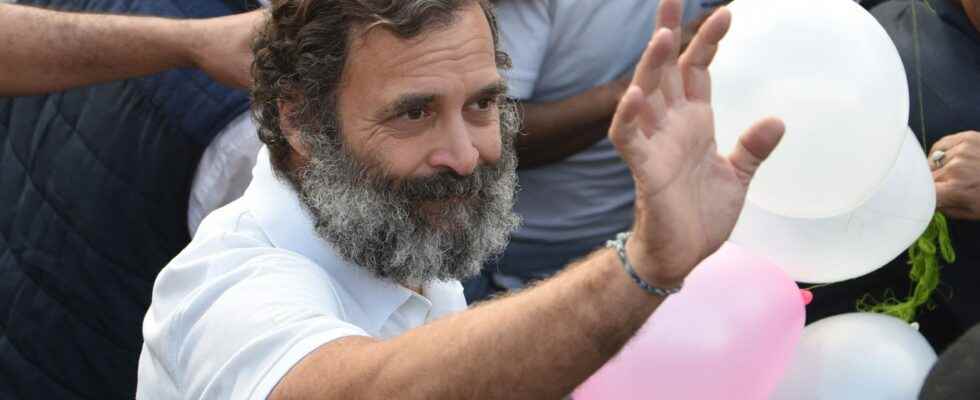They are hundreds gathered at the edge of the road. Wrapped in their shawls, the inhabitants of the vicinity of Unchagaon, a village located about 100 kilometers from New Delhi, braved the cold snap which descended on northern India in the hope of catching a glimpse of Rahul Gandhi. An opposition figure who has long suffered from a credibility deficit, this man who leads the Indian National Congress – the name of his party, usually called “Congress” for short – undertook a 3,500 kilometer march across the country continent. The “Bharat Jodo Yatra”, the march for the unity of India, began on September 7, at the southern tip of the country, and is due to end on January 30 in Srinagar, Kashmir (north-west).
Over one hundred and fifty days, the leader hopes to reconnect with the people and revitalize the mythical party founded in 1885, which really needs it. The latter dominated Indian political life for almost fifty years after independence in 1947. And Rahul Gandhi comes from a family that provided India with three prime ministers: his great-grandfather Jawaharlal Nehru, his grandfather -mother Indira Gandhi, assassinated in 1984, and her father Rajiv Gandhi, assassinated in 1991. But this formation is today a political dwarf next to the all-powerful machine of the Bharatiya Janata Party, the party of the Indian people (BJP) of Hindu nationalist Prime Minister Narendra Modi, in power since 2014.
On this early January morning, Rahul Gandhi begins his 111th day of walking with 200 party walkers. Wherever he goes, the 52-year-old elected arouses enthusiasm. Over the miles, the one who was once called an “empty suit” by American diplomats is forging a new image. “Finally, Rahul Gandhi is a good man, I came to see him and listen to what he has to say,” says Sitab Singh, an 82-year-old farmer who voted for BJP in 2019. Many come with their grievances; some took a day off; a lawyer wants to give him a petition asking for the creation of a new court: “He is in my eyes the most important representative of the opposition capable of bringing our problems to the national scale”, assures Shileha Kaushik. A few steps away, a young farmer, Gaurav Chauhan, shares the “biggest problem” of young people: unemployment. “Here, everyone is a graduate but no one has a job,” he explains.
“India is also my country”
This political trek echoes the “salt march” of Mahatma Gandhi (unrelated to Rahul Gandhi) in 1930. The father of the nation had then traveled 380 kilometers on foot to protest against the salt tax, initiating a movement of civil disobedience to British colonial power. Along his way, Rahul Gandhi exchanges with members of civil society, veterans, activists, all handpicked. “People see him as a mediator capable of making their voices heard, where they can no longer do so, because freedom of expression is being undermined,” said Mohamed Arief, a member of the party’s minority committee and walker since the first day. As a Muslim, I no longer feel safe in India and this march is a way of saying loud and clear that secularism [garantie par la constitution indienne] is not a dirty word; that India is also my country.”
Since coming to power in 2014, Hindu nationalists have practiced Hindutva, an ideology that advocates the supremacy of Hinduism over other religions. Hate crimes against religious minorities, including the 200 million local Muslims, are on the rise.
“Some BJP members ask me why I’m walking, Rahul Gandhi said in December. My answer is: I’m opening a love store in your hate market.” “We are fighting for the soul of the nation,” adds Jairam Ramesh, a former minister who walks alongside him. “Diversity defines India but the BJP uses it to divide the country,” he adds, hoping the message will be heard. In 2023, nine Indian states will go to the polls to renew their local representatives. And there are less than two years left before the 2024 general election.
